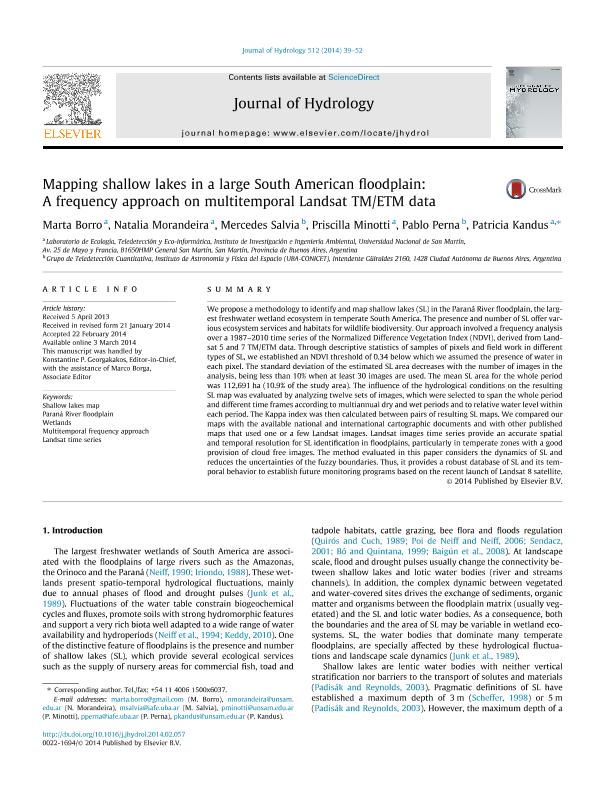Mostrar el registro sencillo del ítem
dc.contributor.author
Borro, María Marta

dc.contributor.author
Morandeira, Natalia Soledad

dc.contributor.author
Salvia, Maria Mercedes

dc.contributor.author
Minotti, Priscilla Gail

dc.contributor.author
Perna, Pablo Alejandro

dc.contributor.author
Kandus, Patricia

dc.date.available
2017-07-28T15:54:35Z
dc.date.issued
2014-05
dc.identifier.citation
Borro, María Marta; Morandeira, Natalia Soledad; Salvia, Maria Mercedes; Minotti, Priscilla Gail; Perna, Pablo Alejandro; et al.; Mapping shallow lakes in a large South American floodplain: A frequency approach on multitemporal Landsat TM/ETM data; Elsevier Science; Journal Of Hydrology; 512; 5-2014; 39-52
dc.identifier.issn
0022-1694
dc.identifier.uri
http://hdl.handle.net/11336/21508
dc.description.abstract
We propose a methodology to identify and map shallow lakes (SL) in the Paraná River floodplain, the largest freshwater wetland ecosystem in temperate South America. The presence and number of SL offer various ecosystem services and habitats for wildlife biodiversity. Our approach involved a frequency analysis over a 1987?2010 time series of the Normalized Difference Vegetation Index (NDVI), derived from Landsat 5 and 7 TM/ETM data. Through descriptive statistics of samples of pixels and field work in different types of SL, we established an NDVI threshold of 0.34 below which we assumed the presence of water in each pixel. The standard deviation of the estimated SL area decreases with the number of images in the analysis, being less than 10% when at least 30 images are used. The mean SL area for the whole period was 112,691 ha (10.9% of the study area). The influence of the hydrological conditions on the resulting SL map was evaluated by analyzing twelve sets of images, which were selected to span the whole period and different time frames according to multiannual dry and wet periods and to relative water level within each period. The Kappa index was then calculated between pairs of resulting SL maps. We compared our maps with the available national and international cartographic documents and with other published maps that used one or a few Landsat images. Landsat images time series provide an accurate spatial and temporal resolution for SL identification in floodplains, particularly in temperate zones with a good provision of cloud free images. The method evaluated in this paper considers the dynamics of SL and reduces the uncertainties of the fuzzy boundaries. Thus, it provides a robust database of SL and its temporal behavior to establish future monitoring programs based on the recent launch of Landsat 8 satellite.
dc.format
application/pdf
dc.language.iso
eng
dc.publisher
Elsevier Science

dc.rights
info:eu-repo/semantics/openAccess
dc.rights.uri
https://creativecommons.org/licenses/by-nc-sa/2.5/ar/
dc.subject
Shallow Lakes Map
dc.subject
Paraná River Floodplain
dc.subject
Wetlands
dc.subject
Landsat Time Series
dc.subject.classification
Sensores Remotos

dc.subject.classification
Ingeniería del Medio Ambiente

dc.subject.classification
INGENIERÍAS Y TECNOLOGÍAS

dc.subject.classification
Oceanografía, Hidrología, Recursos Hídricos

dc.subject.classification
Ciencias de la Tierra y relacionadas con el Medio Ambiente

dc.subject.classification
CIENCIAS NATURALES Y EXACTAS

dc.title
Mapping shallow lakes in a large South American floodplain: A frequency approach on multitemporal Landsat TM/ETM data
dc.type
info:eu-repo/semantics/article
dc.type
info:ar-repo/semantics/artículo
dc.type
info:eu-repo/semantics/publishedVersion
dc.date.updated
2017-07-26T18:15:16Z
dc.journal.volume
512
dc.journal.pagination
39-52
dc.journal.pais
Países Bajos

dc.journal.ciudad
Amsterdam
dc.description.fil
Fil: Borro, María Marta. Universidad Nacional de San Martin. Instituto de Investigación e Ingenieria Ambiental. Laboratorio de Ecologia, Teledeteccion y Ecoinformática; Argentina. Consejo Nacional de Investigaciones Científicas y Técnicas; Argentina
dc.description.fil
Fil: Morandeira, Natalia Soledad. Universidad Nacional de San Martin. Instituto de Investigación e Ingenieria Ambiental. Laboratorio de Ecologia, Teledeteccion y Ecoinformática; Argentina. Consejo Nacional de Investigaciones Científicas y Técnicas; Argentina
dc.description.fil
Fil: Salvia, Maria Mercedes. Consejo Nacional de Investigaciónes Científicas y Técnicas. Oficina de Coordinación Administrativa Ciudad Universitaria. Instituto de Astronomía y Física del Espacio. - Universidad de Buenos Aires. Facultad de Ciencias Exactas y Naturales. Instituto de Astronomía y Física del Espacio; Argentina
dc.description.fil
Fil: Minotti, Priscilla Gail. Universidad Nacional de San Martin. Instituto de Investigación e Ingenieria Ambiental. Laboratorio de Ecologia, Teledeteccion y Ecoinformática; Argentina
dc.description.fil
Fil: Perna, Pablo Alejandro. Consejo Nacional de Investigaciónes Científicas y Técnicas. Oficina de Coordinación Administrativa Ciudad Universitaria. Instituto de Astronomía y Física del Espacio. - Universidad de Buenos Aires. Facultad de Ciencias Exactas y Naturales. Instituto de Astronomía y Física del Espacio; Argentina
dc.description.fil
Fil: Kandus, Patricia. Universidad Nacional de San Martin. Instituto de Investigación e Ingenieria Ambiental. Laboratorio de Ecologia, Teledeteccion y Ecoinformática; Argentina
dc.journal.title
Journal Of Hydrology

dc.relation.alternativeid
info:eu-repo/semantics/altIdentifier/url/http://www.sciencedirect.com/science/article/pii/S0022169414001656
dc.relation.alternativeid
info:eu-repo/semantics/altIdentifier/doi/http://dx.doi.org/10.1016/j.jhydrol.2014.02.057
Archivos asociados
